Origin and History of Lake Grapevine, 1919-1953, Part 1: Beginnings
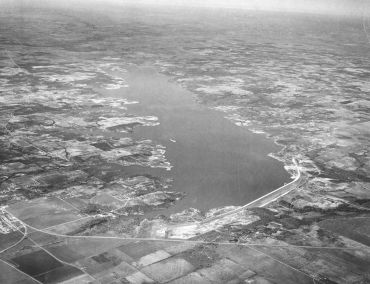
Lake Grapevine is a reservoir situated approximately twenty miles northwest of Dallas and northeast of Fort Worth. Located on Denton Creek, a tributary of the Elm Fork of the Trinity River, it is a popular destination for Grapevine residents and others who come to enjoy fishing, boating, camping, and other outdoor activities. Its origin and history make for a colorful tale.
The lake known today began as the Grapevine Reservoir and Dam project with the breaking of ground at Denton Creek on December 5, 1947, but its origins actually date back to October 1919 in Dallas, Texas. Spanning both Tarrant County and Denton County, it was impounded on July 3, 1952 by the US Army Corps of Engineers (ACE) in order to control flooding from the creek and to provide an additional source of water for future Dallas, University Park, and Highland Park (known as the Park Cities) population growth. The new lake created a stable water supply for Grapevine in addition to controlling annual flooding, thus providing significant benefits to residents. To understand this fascinating story, we will take an in-depth look at the lake’s history and development from its inception in 1919 until it began to fill in 1953.
In today’s blog, we will trace the idea of Dallas wishing to increase its water supply to the possibility of Fort Worth pre-empting Dallas’s claim altogether and how the small town of Grapevine dealt with the situation.
A Water Supply Idea Moves Forward
The proposed increased water supply for greater Dallas, as expressed in the Grapevine projects, was conceived and recommended by the City Plan Commission. On October 1, 1919, its committee on public improvements, sanitation, and water supply recommended that the city engineer make all necessary preliminary surveys regarding the proposed reservoirs in order to meet the demands of a growing city. On October 20, 1920, Major W. J. Powell, engineer for the Dallas Supervisor of Public Utilities, began a preliminary survey and mapping of nine dam sites – three on Denton Creek and six on Elm Fork – that would likely be completed by May 1, 1921.
Almost all the reservoir sites were covered with oaks, cottonwoods, and willows and would take considerable clearing, but the creek was skirted by rich bottomlands, which made excellent farms. The country was not densely populated, and about fifty percent of its farmland had been used for cotton production at the time. Because cotton was gradually being phased out as a cash crop, it was felt that this land could be bought cheaper at that time. Surveyors would determine which sites were most feasible. These sites were within two or three miles north of Grapevine. Advocates of the additional water supply asserted that their plan would embody construction of the Denton Creek reservoirs first; when Dallas’s population reached 300,000, the Elm Fork project could be completed.
And the Survey Said . . .
Major Powell’s report was completed by early March 1921, in which he concluded that out of all the proposed sites, the largest possible reservoir would be the one north of Grapevine on Denton Creek. It would be from two to four times larger in capacity than any of the possible dam sites he and his engineers investigated; a total capacity of 104 billion gallons could be procured at minimum cost. The dam would be earthen with a separate spillway. The report on the site north of Grapevine was the most detailed. The site was considered not only to be the most favorable in terms of maximum area and capacity but because of the lower cost per million gallons of water stored. Water would flow by gravity from the reservoir into already-extant small dams on Elm Fork north of Dallas as needed. It would then be pumped into the filtration plant reservoirs. Thus, the only expenditures necessary would be for the acquisition of needed land for the construction of the proposed reservoir, with no outlay for new pipelines or pumping stations. Allowing for maximum evaporation, Powell averred that the reservoir could supply Dallas during a period of four years with no rain, assuming a population of 500,000 and use of one hundred gallons of water per day per person.
Professor T. U. Taylor of the Engineering Department of the University of Texas, who was a consulting hydrographic engineer for Dallas, had read Major Powell’s report and concurred with him, declaring it was the best site he had ever seen for an artificial lake. Taylor had been retained by Dallas since January 1921 to make a survey of the water situation. Dallas Mayor Sawnie R. Aldredge observed that Denton Creek’s channel was very deep and carried a formidable amount of water. He said that the basin formed by the two great slopes that flank the stream seemed providentially placed for just such a project as this.
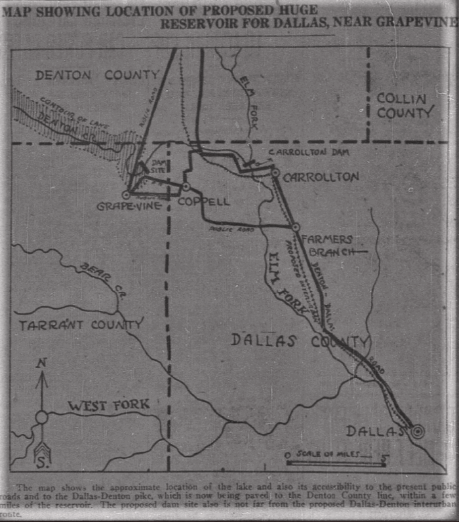
Dallas Morning News, April 10, 1921.
Things Look Up For Dallas
The engineers concluded that the reservoir site was exceptionally prepared by nature to meet the needs of a growing Dallas. It was situated two and one-half miles north of Grapevine, with two parallel bluffs flanking the deep channel of Denton Creek to form a natural basin more than two miles wide and approximately eleven and one-half miles long that was remarkably free of woodland and undergrowth. It was almost directly north of Grapevine, where the ridges narrowed at a point on the A. W. Anderson survey (Fig. 2) in such a way that a dam 5,600 yards long, 450 feet wide at its base, and 105 feet maximum height, would successfully dam Denton Creek and seal the entire channel to form a lake far larger than any similar body of water in this part of the country. Major Powell also explained that because “there are no real towns or communities in that immediate section,” the Denton Creek sites, including that of the big reservoir, would be comparatively free from the threat of pollution.

Unfortunately, no issues of The Grapevine Sun newspaper for 1921 and 1922 exist, so reactions by Grapevine residents about the proposed reservoir must be sought in Fort Worth and Dallas newspapers. Grapevine resident J. E. Christman, in the Dallas Morning News, indicated that he was very pleased with the prospect of a reservoir being built on Denton Creek. “There is absolutely nothing Dallas could undertake at present,” he proclaimed, “that would profit her more in a material way than the building of the big lake.” He felt certain that Dallas “would have no difficulty about getting the land.”
The Denton Record-Chronicle also reported favorably on the Grapevine site, as most of the water created by the project would be in Denton County, and because almost $2,000,000 of the $5,000,000 for labor and constructions costs would affect many Denton County landholders on and near the proposed site. Word soon spread about the possibility of the dam being constructed; an advertisement in the November 2, 1922 Fort Worth Star-Telegram boasted: “CHOICE LOCATION – Farm, improved, 225 acres, North Grapevine, along edge proposed Dallas $5,000,000 water reservoir. Cash or easy terms.”
Water from the reservoir would back up through Tarrant County into Denton County, being dammed at its upper end by the Texas & Pacific Railway tracks that lead into Denton. The estimated cost, including the purchase of the farm, was $5,000,000. The Dallas Technical Club issued a report urging the timely construction of the dam. “It is absolutely essential,” it warned, “that Dallas should have a completed and filled reservoir by 1931-32” or risk suffering an alarming water famine due to anticipated rapid population growth. Mayor Aldredge stated that the decision on whether the greater Denton Creek project in Coppell or Grapevine reservoir would be constructed would be up to Dallas voters in the April 1923 municipal election. On October 2, 1922, Aldredge and over one hundred Dallas citizens took an inspection trip to two proposed sites for the reservoir on Denton Creek near Grapevine (Fig. 3), the other in Coppell.
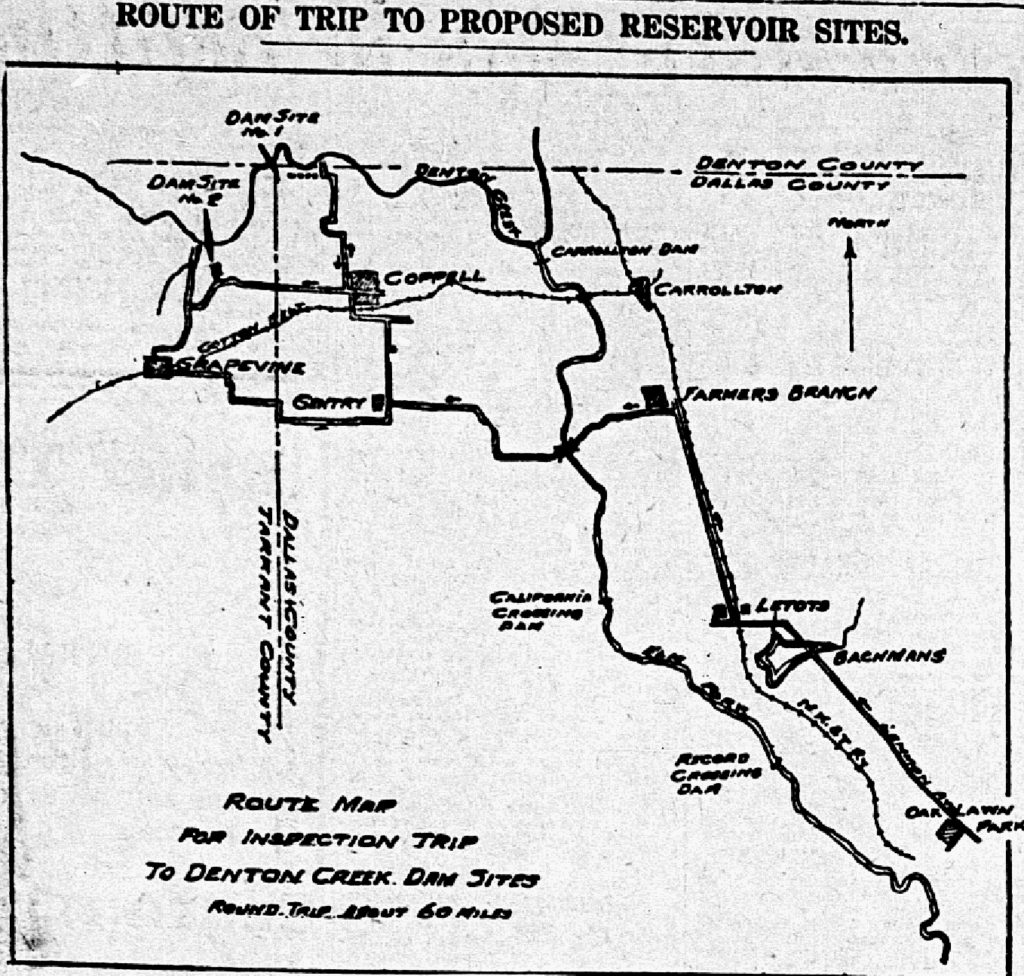
Dallas Morning News, October 1, 1922.
Around noon, Grapevine businessmen provided a chicken meal. Many women prepared the meal (“100 spring chickens, fried to a turn”) on tables near the promontory overlooking the site. Several citizens and visitors made short addresses, and cooperation was offered in case the Grapevine site was selected (Figs. 4 and 5).
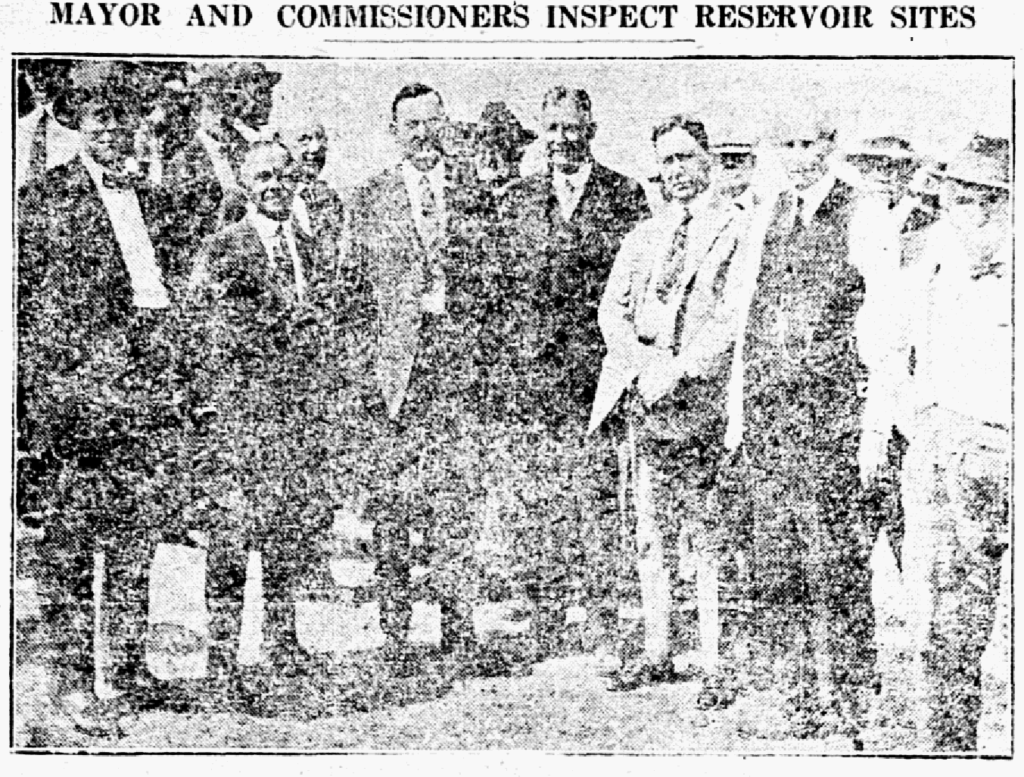
Dallas Morning News, October 4, 1922
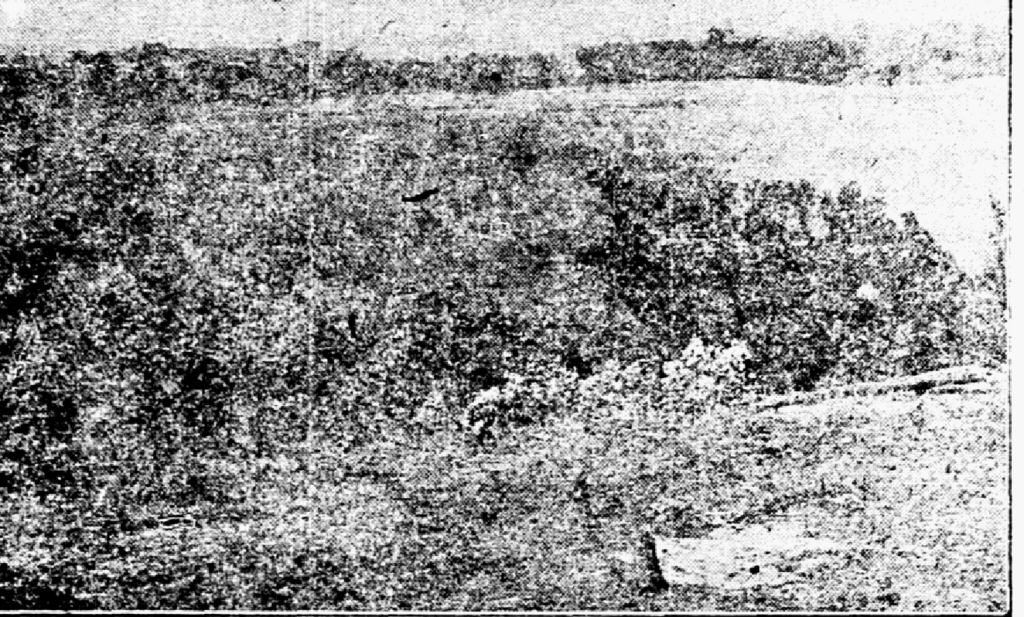
Dallas Morning News, October 4, 1922.
Fort Worth In The Wings
The Sullivan Machinery Company was awarded the contract for drilling tests to determine the foundations of the two sites, beginning on October 18, 1922, and completing them within sixty days. In November 1922, respected geologist Dr. Robert T. Hill was brought in to work with the Dallas engineering department in making a geological survey of the Denton Creek projects. Dr. Hill’s report stated that foundation difficulties revealed by the borings on the Grapevine site could be overcome by proper design and construction methods. The engineer in charge was apparently concerned about his workers’ conduct; the Southern Methodist University student newspaper Semi Weekly Campus of January 27, 1923 noted that he would not allow any profanity from the men, and wryly suggested that if that was his policy, he might actually have to abandon the dam.
By April 1923, the Dallas Board of Water Engineers singularly recommended giving all precedence to the Grapevine reservoir. On January 10, 1924, a Grapevine delegation visited Dallas in support of the Grapevine location on Denton Creek. Grapevine Mayor Drew D. Wall sent a telegram to Dallas Mayor Louis Blaylock indicating that Grapevine citizens would fully cooperate in securing lands necessary for the reservoir. Engineers at the site observed that it was one of two sites that could impound 31 billion gallons during a dry year with a negligible inflow, not including seepage and evaporation. W. K. Stewart of Grapevine informed Dallas Water Commissioner Harry H. Gowins on February 14, 1924 that Fort Worth residents who held property rights on the creek would surrender them if Dallas wanted to use it for the reservoir. Stewart asserted that documents of the priority rights would be placed in escrow in a bank to be turned over to the city if the Grapevine site was wanted.
In the meantime, however, Fort Worth was equally determined to secure its water supply by holding a county-wide election on October 7, 1924, that, if passed, would create a county water conservation district and a five-member board of directors. Passage would give Fort Worth the legal authority to control Trinity River water projects in Tarrant County. Grapevine residents Sandy A. Wall, Frank Estill, W. H. Bogart, Hugh M. Hightower, and John Morrow spoke in favor of the district at a meeting held in Fort Worth on September 13, 1924. Individual meetings were then held all over Tarrant County to strongly urge citizens to vote in favor of the district. The meeting at Grapevine was held on September 27, 1924. Once the decision was made to put the conservation district proposal on the ballot, however, the Denton Record-Chronicle noted that if the measure passed, Tarrant County might legally pre-empt Dallas’s effort to claim the Denton Creek site.
But the proposed conservation district decreed that if any incorporated towns in Tarrant County (Grapevine, Arlington, Mansfield, or Fort Worth) cast a majority of negative votes against the district’s creation, they could not, by law, ever get into the district again on the present basis. Neither could they get water or share the benefits. This was considered such an important matter that on October 2, 1924, school authorities announced that students residing in those towns were asked to remind their parents the day before the October 7 election to get out and vote. On October 5, W. G. Turner, one of the five members of the proposed water district, spoke to a gathering of Grapevine residents headed by Sandy A. Wall, along with M. H. Moore, superintendent of Fort Worth schools, and W. E. Bideker, a twenty-year proponent of conservation. They asserted that a vote for the creation of the district would benefit the entire county, not just Fort Worth (Fig. 6).
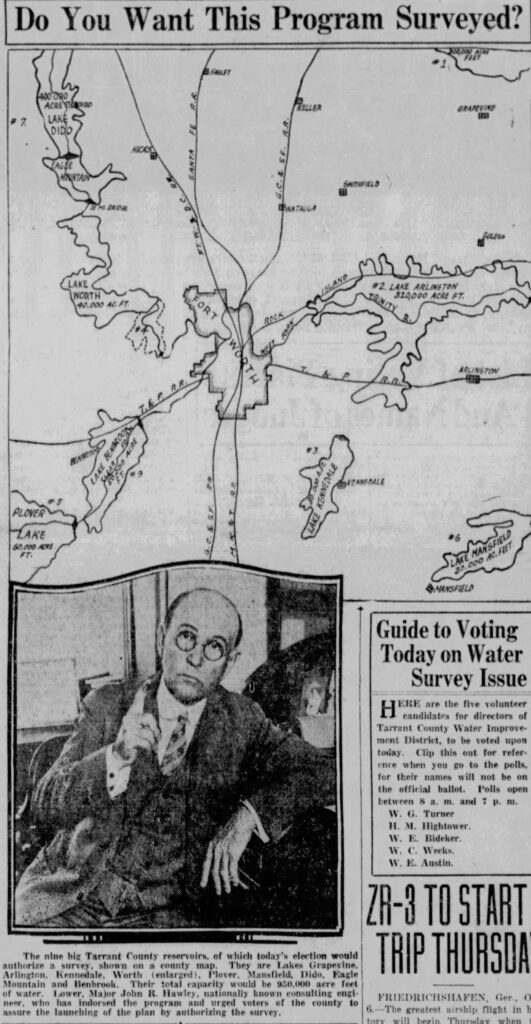
Fort Worth Record, October 7, 1924.
Storm Clouds Appear
The matter was put to a county-wide vote on October 7. Turnout was light, which was regarded as dangerous by the conservation board. Feelings at Grapevine were divided; at the Woodmen of the World Hall, only seventy-five votes had been cast by noon, which prompted some proponents to rush to Grapevine to help swing sentiment and get out a larger vote. In spite of their efforts, the city voted 159 against and only twenty-nine in favor. Rural Grapevine voted sixty-eight against to ten in favor. The disappointed Star-Telegram suggested that Grapevine’s negative vote was the result of a misunderstanding of the project rather than a conscious decision. It posited that perhaps voters didn’t perceive that the reservoir could allow them to become an industrial center with a huge water supply at a “ridiculous[l]y cheap rate,” and to develop “thousands of acres of farm lands . . . through irrigation.” The newspaper urged the town to reconsider and call a municipal election. Because of Grapevine’s decision, however, the board did not want to start building across Denton Creek. But Tarrant County Water Conservation District No. 1 became a reality.
The district board of directors proposed to construct a series of dams and retaining reservoirs on rivers and streams in Tarrant County under Senate Bill No. 169, which was passed by the Texas Legislature in early February 1925. The bill was intended to provide “for the organization and government of Water Control and Improvement districts” with powers broad enough to deal with all possible phases – flood control, irrigation, and water supply – as allowed by the Texas constitution. The law then in place allowed a district to deal with only one of the three phases.
In late 1925, the water district called for an election on January 12, 1926 for a new board of directors, as well as to determine whether the district would continue under state direction or be withdrawn as a project. No bond issues were at stake. Proponents claimed that voter failure to adopt this measure would endanger the Tarrant County Water Improvement District. However, some Tarrant County citizens against the proposal placed a political advertisement in the Star-Telegram on January 10, 1926, denying that rejection of such a proposal would endanger the district. Instead, they claimed the proposal would remove the established limits of voting on bonds to one-fourth of the value of the property and would deny farmers whose land could not be irrigated the right to petition the board for exclusion of their land in the district. One of the opponents listed was “Dick Wall” (Benjamin Richard (B. R.) Wall) of Grapevine, an attorney who owned property on Denton Creek. He had also served as town mayor from 1912-1914, 1916-1917, 1919-1920, and would serve again from 1933-1947.
The board’s proposal went to the voters on January 13. As residents of Precinct No. 35 in the water improvement district, Grapevine citizens cast their ballots at the Woodmen of the World Hall. Myles A. Buchanan was the presiding officer for the precinct; Cal Estill, Miss Ellen Sanders, and Mrs. Max H. Frank were the judges. When the election was over, voters had rejected the measure by a vote of forty-three against and two in favor. Grapevine would not be part of the Tarrant County Water Improvement District.
Unfortunately, many issues of the 1920s and 1930s Grapevine Sun are missing, including all of 1921 and 1922, so it is not possible to know whether there was further discussion in that paper about Grapevine’s rejection of both Tarrant County propositions or about the Dallas-proposed Grapevine reservoir during that time. The subject of the Grapevine Dam and Reservoir Project did not come up in extant issues of the Grapevine Sun again until the mid-1940s, but it still lingered in the minds of Dallas and Fort Worth officials in the late 1930s. In the next blog post, we’ll examine how the idea of the Grapevine Dam and Reservoir never went away; instead, it shifted from the local level to the national level after the first general flood control bill was passed by Congress and signed by President Franklin D. Roosevelt in 1936.



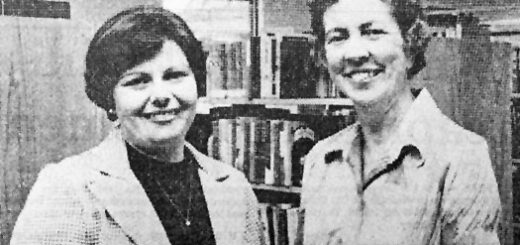
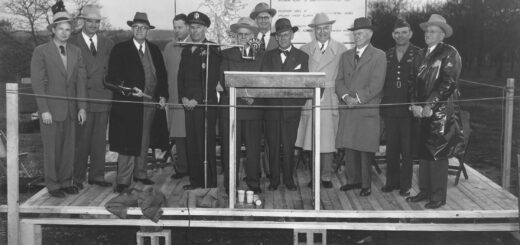
Recent Comments